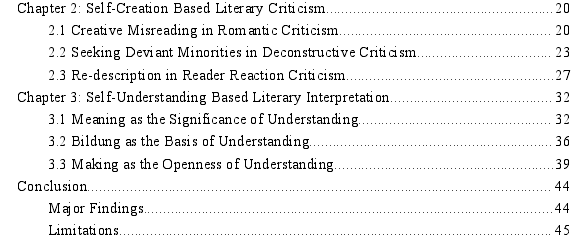文学理论论文哪里有?本文从自我价值、自我创造和自我理解三个方面论证了罗蒂的语用文学理论建构了有限主义的人文精神。人文主义的有限主义,被称为“后人文主义”,关注个体的自我。人文主义有限主义通过承认人类存在的偶然性和经验的局限性,并不刻意追求人类的普遍性,而是注重实践所产生的人格特征。因此,罗蒂的观点更多的是文学理论,而不是哲学辩论。罗蒂所推崇的“后哲学文化”是一种“文学”文化,它使罗蒂成为“新人文主义文学家”的代表,而不是哲学家。显然,罗蒂的文学理论体现了对人文主义的珍惜和维护。这是继“理论”之后的“人本主义”之路。
Chapter 1: Self-Value Based Literary Function
1.1 The Self-Value of Achieving Self-Perfection
This part discusses the aesthetic characteristics of literature itself with the concept ofcontingency and irony. By criticizing the essentialism of traditional philosophy, Rortyadvocates aesthetic bliss in Marcel Proust’s In Search of Lost Time, believing that the essenceof the world is full of accidental coincidence, creation instead of discovery is the key topersonal perfection. In this part, Marcel Proust’s In Search of Lost Time will be analyzedbased on two key concepts of Rorty: contingency and irony, aiming to prove that literaturehas the function of promoting self-perfection in a private realm.
First of all, contingency is one of Rorty’s key concepts. In the history of Westernphilosophy, contingency and necessity are two concepts used to explain the origin of things,displaying different perspectives and attitude towards the world. Traditional philosophyinsists on the significance of necessity, while modern philosophy advocates contingency.Among them, Rorty’s point of view is the most typical. He makes arguments with purecontingency to deconstruct traditional philosophy’s concepts of truth, ego, universality, andessence. Rorty once claimed: “I hate logic, formalism and everything that has a timelessmeaning, and everything that refuses to be an accidental thing.”(Rorty 1979: 75) According toRorty, compared with traditional philosophical words, human beings are more closely relatedto “randomness”, “uncertainty” and “contingency”. In Proust’s In Search of Lost Time, twolevels of contingency are demonstrated: the contingency of language and the contingency ofselfhood. As for contingency of language, traditional philosophers believe that language,which truly reflects essential things, is an eternal entity independent of the objective world.They believe that truth exists there, only to be found by certain people. Rorty denies this viewand puts forward the fact that language is the product of contingency. He points out thatlanguage, with no essence, is a concrete, individual and accidental existence. As he said: “Ourlanguage and our culture, like orchids and great apes, are just accidents, just a result ofthousands of small mutations that have been located (and countless other mutations that havenot been located).”(Rorty 1979: 77) Rorty believes that according to what beliefs humanbeings speak of their language is sometimes a random result rather than a deep expression inthe heart, language is nothing but a tool, providing various descriptions of the world. Hestrongly agrees with Davidson that language is a “metaphor” that has nothing to do withdescribing the nature of objects.

Chapter 2: Self-Creation Based Literary Criticism
2.1 Creative Misreading in Romantic Criticism
Rorty’s post-humanistic literary criticism is deeply influenced by the trend ofromanticism. He praises the romantic philosophers such as Hegel, Nietzsche and Heidegger.Besides, many of his literary heroes, such as Whitman and Emerson, are also romanticists. Inthe book Romanticism and Pragmatism, Rorty elaborates on the pragmatism’s use ofRomanticism. As for Rorty, pragmatism’s use of romanticism is an integral part of a modernanti-universalist story of progress. In the book University Grandeur, Romantic Depth,Pragmatist Gunning, Rorty follows Isaiah Berlin, regarding the concept of the revival ofromanticism not as a literary trend opposite to classicism, but as a thought movement againstthe paradigm of universalist discourse. Berlin, in the Roots of Romanticism, points out that thecontribution of romanticism is to smash the world view of “puzzle” that has been popular inwestern society until the late 18th century. Traditional philosopher hold that life is like ajigsaw puzzle that consists of various fragments. It is the tiny bits of fragments that makes upof the basis of human lives. The essential features of these fragments and the significance oftheir existence are about to be explored by those who utter the final word, or to say, theomniscient God. (Berlin 2015: 23) They regard human life as solving the “puzzle” problem,which is an inevitable result of universalist thinking. They believe that the real knowledge isto find these pieces and stitch them together to form a complete picture of the world. With this picture of the world, people would find answers to all the ultimate questions from the past topresent such as “what is the nature of the world?”, “what is the nature of human being?” and“what is the meaning of human existence?”. Romanticism weakens the assumption held byPlato-Kant that there is a better argument which has universal reliability, and that there issomething right that we should do or believe. Therefore, the depth of romanticism hasreplaced the height of rationalism’s universality. Berlin declares that Romanticism as thetrend of thought, enlightens human beings that the nature of the world is invented notdiscovered, is generated not found. (Berlin 2013: 87). As a follower of Berlin, Rortyvigorously criticizes universality with validity, but prone to romanticism which offers spacefor imagination and creativity.
Chapter 3: Self-Understanding Based Literary Interpretation
3.1 Meaning as the Significance of Understanding
Meaning, in the field of epistemology, is equivalent to the truth and essence of the text.The main problems traditional epistemology tries to solve are universal necessity andobjectivity of knowledge. And there are always fixed essence and meaning waiting for readersto discover. However, as a pragmatist, Rorty argues that meaning is constructed rather thandiscovered, it cannot be independent of people’s life and practice, purpose and interest. In thissense, every interpretation of the text is a “re-description”, text is already being used when itis being interpreted. In the “Tanner Lectures”, Rorty puts forward the idea that “interpretationis free from constriction”, which derives from his depreciation of certain discourse privileges,hoping to realize the “popularization” of culture. As far as Rorty is concerned, acknowledgingthat interpretation is constrained means acknowledging that one interpretation is superior toanother, and the existence of this compulsive force is the least thing Rorty wants to see. InRorty’s view, all interpretations follow the intention, purpose, or need of present time andplace. Since the intention, purpose and need are different from person to person, varied withtime and place, the interpretations of those are unlimited and unconstrained. The openness ofthe interpretation brings the openness of meaning, and the openness of meaning is thesignificance of self-understanding. It is worth to notice that Rorty’s ideas about textualinterpretation originate from his profound pragmatic thoughts: anti-essentialism and the ideaof “meaning is in use”. In order to analyze Rorty’s textual interpretation more clearly, thispart stresses Rorty’s anti-constraint thought from two sources: one is Rorty’s anti-essentialism thought, the other is Rorty’s anti-essentialism of “meaning is in use”. From these two aspects,it aims to prove that meaning is the significance of understanding.
3.2 Bildung as the Basis of Understanding
By claiming that hermeneutics is largely a struggle against traditional epistemology,Rorty further declares that “hermeneutics is not a name for a discipline, nor a method ofachieving the sort of results which epistemology failed to achieve, nor for a program ofresearch. On the contrary, hermeneutics is an expression of hope and the way to deal with theworld.” (Rorty 1999: 315) On this basis, Rorty’s post-philosophical culture and Gadamer’shermeneutics reach a horizontal fusion. As a famous representative of hermeneuticalphilosopher, Gadamer points out in his book Truth and Method that hermeneutics is not amethod of obtaining truth but provides us with a “world of meaning”. Hermeneutics putspeople in the larger picture or background of the “world of meaning” and re-describes people,rather than limit the nature of people by discovering the nature of the surrounding world likemirror epistemology. For this reason, Gadamer replaces the concept of “knowledge” as thegoal of thinking with the concept of “Bildung” which refers to education and self-formation.In this attitude, Rorty goes along with Gadamer in believing that finding a new and moreinteresting way of expressing ourselves, thus of coping the world is predominantly importantthan getting the facts right. Therefore, by benefiting correctly from the concept of “Bildung”,Rorty conceived of using the word “Edification” as a substitute to represent the discovery ofnew, better, more interesting and more productive ways of speaking. He believes that to edifypeople themselves or others is the hermeneutic activity that establishes a connection betweenthe incommensurable our own culture and a certain foreign culture, the incommensurable ourown discipline and other disciplines. Edified discourse should be beyond rules, which uses thepower of aliens to make people adopt new ways to deal with the world. Under thiscircumstance, this part first discusses Rorty’s comparison between systematic philosophy andbildung philosophy, then proves that bildung, in Rorty’s mind, is essentially dialogue, so as toprove that bildung is the basis of understanding.

Conclusion
Major Findings
Rorty’s theory of “post-humanism” is by nature, a kind of “humanist finitism”, with twoprominent features. On the one hand, it is a thought movement against the paradigm ofuniversalist discourse. On the other hand, it is liberal humanism focusing on the specificactions of limited individuals. From the discussions above, it can be observed that thehumanistic spirit of finitism is constructed in Rorty’s pragmatic literary theory, whichreflected itself in Rorty’s understanding of literary function, literary criticism, and literaryinterpretation.
In Rorty’s pragmatic literary theory, the function of literature is reflected in theconstruction of self-value. In the private realm, the function of literature is to promoteself-perfection. Rorty’s ideals of contingency and irony can be mobilized as paths towardself-perfection, which highlight the value of a finite but independent individual. In the publicrealm, the function of literature is to promote social solidarity. For Rorty, the existence ofdifferent solidarity is often a source of moral conflict, the top priority of which is to reducecruelty. There are two kinds of descriptions of cruelty. Rorty believes that literature can makepeople more sensitive to suffering and pain, thus facilitates the capacity for awareness, andempathy for others. It is in this way literature functioned that self-value is achieved in bothprivate and public realm. Besides, self-creation is reflected in literary criticism. Humancreation, as for Rorty, is not merely the recombination of the existing available materials, buta transformation of reality into novel things with the help of conscious activities of anindividual. In Bloom’s romantic criticism, self-creation represents itself in creativemisreading, which focuses more on the openness and diversified interpretations of reading,stressing the principal body with independence, initiative, and creativeness. In Derrida’sdeconstructive criticism, self-creation represents itself in deviant minorities, which meansinterpreting the text as a process of continuous self-betrayal, self-transcendence, andself-reversal, thereby creating self-contradiction in the text. In Stanley Fish’s reader reactioncriticism, self-creation is expressed in the idea “meaning is event”, which highlights theinitiative and feeling of the reader himself. Rorty believes that in literary criticism, in this way,highlights the self-creation of individuals. Moreover, in literary interpretation,self-understanding is manifest in three concepts, which are “meaning is in use”, “bildung isessentially dialogue” and “making rather than finding”. For Rorty, Gadamer plays afoundational role in applying hermeneutics into practice. As for pragmatists, the way that people do to anything in the world is a kind of “use”. Interpreting, knowing and describing arenothing but different ways of using things; bildung is an exchange activity between subjects, abreak from boundaries, which is equal to dialogue that can achieve self-understanding;“Making”, as the core element of practical hermeneutics, becomes the openness of personalunderstanding. To establish a new order is the base of understanding a new self. Rortybelieves that though literary interpretation, people could get chance to a betterself-understanding.
reference(omitted)

